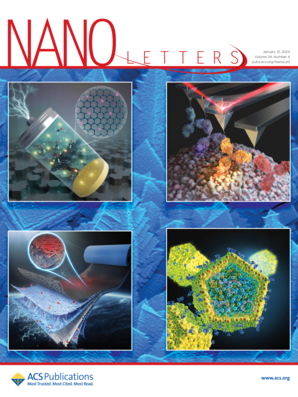Design and Control of Three-Dimensional Topological Magnetic Fields Using Interwoven Helical Nanostructures
IF 9.6
1区 材料科学
Q1 CHEMISTRY, MULTIDISCIPLINARY
引用次数: 0
Abstract
Three-dimensional (3D) magnetic nanostructures are an emerging platform capable of creating complex topological magnetic fields. The control of localized nanoscale magnetic fields is seen to be of importance for diverse areas from bioapplications such as drug delivery, to particle trapping and controlling Majorana Fermions for quantum computing. Three-dimensional geometric confinement and proximity can create tailor-made spin textures not possible in two dimensions. The control of magnetization afforded here can allow the formation of unique stray field textures. Here, we report the creation of reconfigurable 3D topological magnetic field textures induced by an interwoven 3D nanostructure and applied field protocol. These field textures emerge due to distinct DWs formed in this structure and lead to the creation of an antivortex field, a hexapole cusp and a 3D skyrmion field tube of mixed chirality. Our results therefore show a key step toward the design and control of topological magnetic fields on the nanoscale.

求助全文
约1分钟内获得全文
求助全文
来源期刊

Nano Letters
工程技术-材料科学:综合
CiteScore
16.80
自引率
2.80%
发文量
1182
审稿时长
1.4 months
期刊介绍:
Nano Letters serves as a dynamic platform for promptly disseminating original results in fundamental, applied, and emerging research across all facets of nanoscience and nanotechnology. A pivotal criterion for inclusion within Nano Letters is the convergence of at least two different areas or disciplines, ensuring a rich interdisciplinary scope. The journal is dedicated to fostering exploration in diverse areas, including:
- Experimental and theoretical findings on physical, chemical, and biological phenomena at the nanoscale
- Synthesis, characterization, and processing of organic, inorganic, polymer, and hybrid nanomaterials through physical, chemical, and biological methodologies
- Modeling and simulation of synthetic, assembly, and interaction processes
- Realization of integrated nanostructures and nano-engineered devices exhibiting advanced performance
- Applications of nanoscale materials in living and environmental systems
Nano Letters is committed to advancing and showcasing groundbreaking research that intersects various domains, fostering innovation and collaboration in the ever-evolving field of nanoscience and nanotechnology.
 求助内容:
求助内容: 应助结果提醒方式:
应助结果提醒方式:


